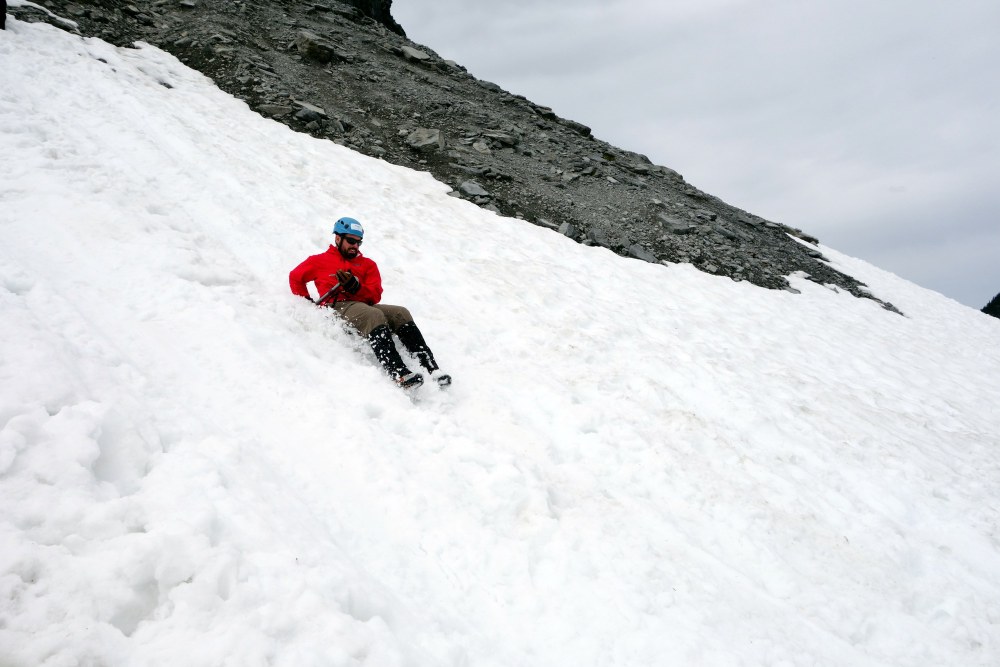
A group was recently out on Mt. Baker for an instructional session that was to be immediately followed by a climb of the mountain via the Easton Glacier.
The day before the climb was spent reviewing snow walking techniques, crampon and ice axe techniques, and eventually glissading and self-arrest. The instructor knew there were students in the group with a history of shoulder and knee issues, so a warning was issued to the group to be cautious during the exercises. After successfully working through a progression of basic glissading techniques and self-arrest maneuvers, the group was ready to move on to the next lesson. The instructor told everyone to do one final run and meet at the bottom of the slope where most of the students had left their backpacks.
One student had brought his pack with him up to the top of the slope and left it there for the session of arrest practice. He hiked back up to the top to retrieve the pack and did one final glissade. Unfortunately, this student (who had a history of shoulder dislocations) allowed too much speed to build up before attempting to arrest. When he attempted to stop, the force of the arrest dislocated the shoulder and sent him into a tumble.
Once he came to a stop, the student was slightly shaken and was holding his shoulder. The instructor asked to help, but the student wanted to try applying traction by himself. After a few minutes, the shoulder popped back into place and the student appeared much more comfortable. He asked if anyone had any Advil or Aleve, and was given 2 Aleve. A plastic baggie was filled with snow and placed on the shoulder, and his arm was immobilized by rolling it up in the bottom of his jacket and wrapping another jacket around him. He sat down on a pack and was made comfortable and warm.
Within a half hour, the student was feeling much better and commented that the last time he dislocated his shoulder, his arm was numb for days after the incident, but this time he already had almost full sensation back. By the end of the day, he had almost full motion back in his shoulder with little to no pain. He was allowed to complete the climb the next day and had only minor soreness in the shoulder.
Lessons Learned
While glissading can be one of the more fun ways of getting down a mountain, it is also one of the more dangerous. The instructor knew there was a potential for injury, and knew there were individuals in the group that had a history of shoulder and knee issues. He warned the group to be cautious, but maybe should have pulled the individuals aside to really discuss their past issues and also discuss the consequences of injuring themselves at this point.
If the injury would have been more severe or the dislocation could not have been reduced, it would have meant the end of the trip for not only the student, but at least some of the others in the group - if not the entire group. If the leader had to evacuate the climber, the group would not have had enough rope leaders for the trip. A frank discussion of these consequences might have carried more weight with the students who had past issues, and maybe more caution would have been used.
Dislocations are just one way to injure yourself during glissading and self-arrest. You could cut, stab, or fully impale yourself on the spike or pick of the ice axe. You could hit yourself in the face or head with the adze. Injuries to a numerous variety of joints, from ankles to shoulders to fingers, are all possible. There are also issues of being cold and wet from sliding around in the snow. And on top of all of this, there are objective hazards as well.
4 rules for glissading:
- Never glissade on a glacier
- Never glissade while roped up
- Never glissade with crampons on
- Always have a clear and visible run-out
I was slightly horrified when I recently saw a glissade chute on one of the steepest parts of the Roman Wall on Mt. Baker - and it headed right for a huge crevasse!! I pointed this out to the group that was with me, and they all agreed to the idiocy of it. Why would you hurtle yourself towards the gaping maw of a huge crevasse?
Next time you are glissading, whether you are teaching it to students for the first time, or just headed down from that amazing summit you just reached, be sure it is an appropriate time and terrain to do it, and be sure the group knows how to do it as safely as possible. Make sure the group is aware of the hazards and make sure the benefits of getting down a bit faster outweigh all the risks.
Add a comment
Log in to add comments.A girl died at Asgard Pass a few years ago while glissading. She fell through the snow and got trapped in icy water. http://www.spokesman.com/blogs/outdoors/2011/jul/05/details-hikers-deadly-slide-alpine-lakes-wilderness/
 James Pierson
James Pierson